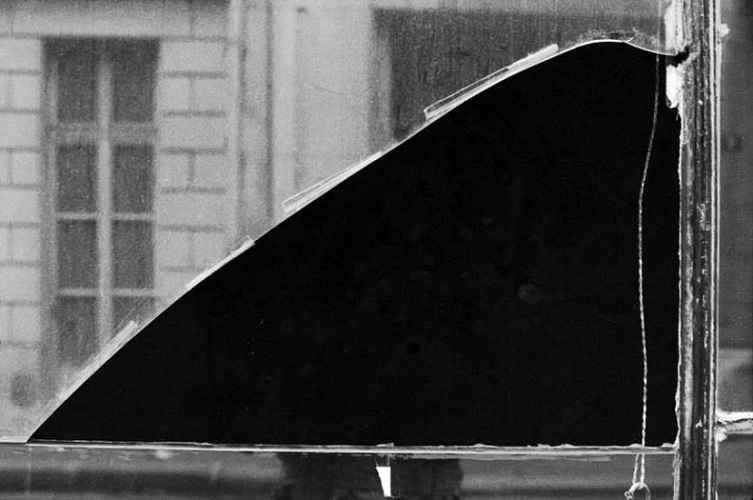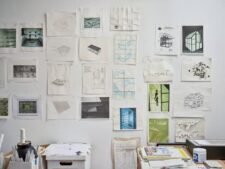
Ellsworth Kelly
American, 1923-2015 (active France)
Broken Window, Paris, 1978
gelatin silver print
11 × 14 in.
Ellsworth Kelly Foundation, Spencertown, New York

Ellsworth Kelly undated photograph
"I think that if you can turn off the mind and look only with the eyes, ultimately everything becomes abstract." - Ellsworth Kelly

Ellsworth Kelly's Home Studio
COMMENTS
Another behind-the-scenes look at Kelly’s practice will come through an exhibition opening in the fall at the Santa Barbara Museum of Art, focusing on Kelly’s photography. A show linking his photographic work to his paintings and sculptures, it will run from October 15 through January 14, 2024.
Kelly began taking pictures in Paris in the 1950s, while a student at the École des Beaux-Arts, which he attended on the GI Bill (he’d served in the 603rd Engineers camouflage battalion during World War II, designing decoys with other artists and architects). “Photography is for me a way of seeing things from another angle. I like the idea of the interplay of two and three dimensions,” Kelly said about his approach to this medium.
Photography was a tool for Kelly to flatten what he saw in the real world into distinct shapes that could be simplified and separated on canvas. “I want to make a shape that somehow or other is in my mind, or that recalls something once seen,” Kelly told photographer Charles Hagen in 1991. “When you look at the world, everything is separate—each thing is in its own space, has its own uniqueness. When I take photographs I want somehow to capture that.”
https://www.artnews.com/list/art-news/artists/ellsworth-kelly-art-exhibitions-museums-100-years-1234670017/1234670028/
Long before his death last year, at the age of ninety-two, Ellsworth Kelly had secured a place for himself in the pantheon of American art. The list of major museums that do not hold his work in their collections is miniscule, and the edifice of his achievements—capped by the National Medal of Arts, awarded to him by President Barack Obama, in 2012—looms above artists of a certain stripe like an aesthetic El Capitan. But while his exuberantly colored shaped canvases, which sent ripples of influence across Minimalism, Pop art, and beyond, are familiar to almost everyone with a passing knowledge of postwar art history, his photographs—from which many of these iconic canvases draw their inspiration—remain almost completely unknown.
This historical lacuna has now been filled by an elegant exhibition of Kelly’s black-and-white photographs at Matthew Marks Gallery, his longtime dealer. The pictures were taken across four decades (the earliest work dates from 1950; the latest from 1982), and cover many locales, from France, where Kelly spent his formative years after the Second World War, to Long Island, Los Angeles, and the areas around his home in upstate New York. Despite this range in material, the images remain resolutely tethered to the formal concerns of his paintings, illuminating far more about his evolving thoughts on art and abstraction than they do about the time and place in which they were made.
Most of the earliest works in the show, all taken in the seaside town of Meschers, in Southwestern France, are studies of timeworn surfaces: the weathered side of a barn, its boards haphazardly cobbled; a mismatched patch job in a wall, where the celestial mottling of old stone is interrupted by utilitarian brick; the side of a striped canvas beach cabana, mended enough times that it looks like a Japanese boro blanket. Each picture bears a resemblance—in both form and spirit—to Kelly’s earliest paintings, which were stuttering, syncopated affairs, their composition and color choices determined by chance, a technique that he borrowed from his friend Jean Arp.
A few later photographs retain traces of this early cut-up style of composition—broken rays of light filtered through the slats of a Long Island boardwalk, shadows fractured by a staircase in St. Martin—but most evolved in tandem with his shaped-canvas works and so they feature bold, beguiling forms that Kelly plucked out of the landscape with his camera. Some of these shapes—the yawning hatchway to a cellar, the pristine rhombus of a drive-in movie screen, a remarkably elegant break in a windowpane—dominate their pictures, sitting in the frame stubborn and plainspoken, being what they are. In other images, particularly Kelly’s photographs of barns, the shapes come at you less directly, slowly floating out of the composition like the answers to a perceptual riddle.
Trawling back through the history of photography, the most direct relative of these works is perhaps the photography of Lewis Baltz, whose rigorous, stark pictures from the nineteen-seventies of bland industrial parks and ticky-tacky housing developments mapped Minimalist aesthetics onto architectural eyesores with a cool, acerbic wit. But Kelly’s photographs are less analytic, besotted as they are with the joy of discovering forms rather than with making diagnoses, whether architectural, cultural, or otherwise. In both his photographs and his shaped canvases, Kelly was engaged in building an idiosyncratic visual alphabet, with each letter chiseled down to the bedrock of form, color, and scale.
Despite all this, Kelly is not entirely immune to content. Many of his photographs exude a pastoral easiness that verges on the sentimental, though you would have to be exceptionally hard-hearted to declare this a negative attribute. And one early work from his time in Meschers injects a note of disquiet into the exhibition. In it, a twisted garden of rebar is silhouetted against an overcast sky, the remnants of a bunker shelled into oblivion during the war. It recalls some of my favorite of Kelly’s works, his tremulous drawings of plants and flowers, which speak so sparely of life’s beauty and its ultimate fragility.
https://www.newyorker.com/culture/photo-booth/joyful-forms-the-little-known-photography-of-ellsworth-kelly
